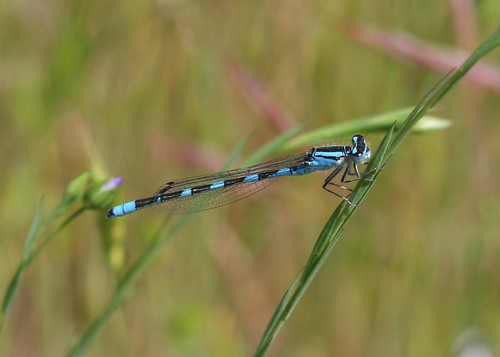In his superb book on the subject, Macro Photography for Gardeners and Nature Lovers, Alan Detrick strongly recommends two things for improved success in recording close-up, highly detailed images: use a tripod to steady the camera, and use a remote or cable release to prevent the minute amount of camera shake that can be caused simply by pressing the shutter release. Once I began doing both these things my macro photographs improved considerably. However, as most field photographers will likely admit, it is also sometimes possible to forego the rules, cash in a large amount of your photographic karma, and simply get lucky.
Take, for example, this image of a Tule Bluet damselfly, Enallagma carunculatum, I recorded at Basket Slough National Wildlife Refuge, not too far west of Salem, Oregon. While walking up a sunny hillside covered with Western Blue Flax, I noted a tiny, bright blue streak cross my field of vision, dart about nearby, and finally light on a flax stalk not far from where I stood. While my camera was in hand, my tripod was strapped across my back. I sensed that the damselfly would not remain long where it was perched; thus I decided to crouch, approach, and – despite a double espresso drunk earlier that morning – hope for the best.
I managed to get what would loosely pass for a respectable amount of focus on the subject and depress the shutter release button six times before the damselfly departed. Would I have preferred to have used my tripod and release? Absolutely! Aside from reducing camera shake, it also makes refining the focus easier (macro work reduces the depth of field to a mere sliver of a focal plane, so long insects such as damsel and dragonflies are tricky as their abdomens are often askew to the plane). However as we all know, damselflies like most other wild creatures, have not the slightest interest in being photographed and as a result can be highly persnickety models. Sometimes “the best you can do” is the best you can do.
—
Equipment:
Camera body: Canon 40D
Camera lens: Canon EF 100mm f/2.8 USM Macro
Tripod: no tripod; photo taken off-hand
—
Resources:
Dragonflies & Damselflies of the Willamette Valley, Oregon, Steve Gordon and Cary Kerst, CraneDance Publications, ISBN-10: 0970889550
Macro Photography for Gardeners and Nature Lovers, Alan L. Detrick, Timber Press, ISBN-13: 9780881928907
If you enjoyed reading this, please consider signing up for The Well-read Naturalist's newsletter. You'll receive a helpful list of recently published reviews, short essays, and notes about books in your e-mail inbox once each fortnight.

